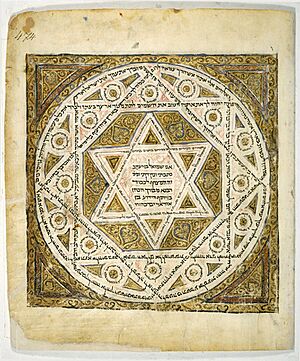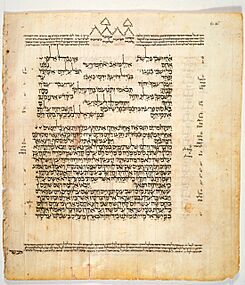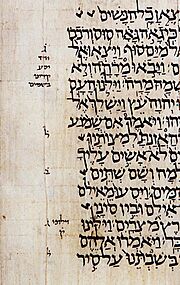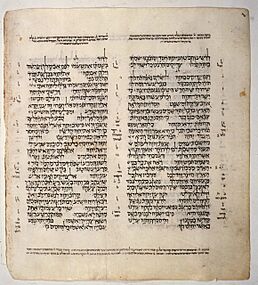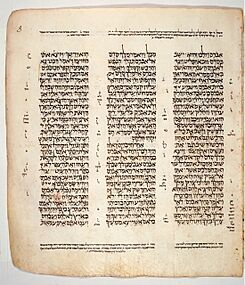Leningrad Codex facts for kids
The Leningrad Codex is a very old and important handwritten book. It is the oldest complete copy of the Hebrew Bible (also known as the Tanakh) that we know of. This special book was made in Cairo, Egypt, around the year 1008 AD.
It uses a specific style of Hebrew writing called the Masoretic Text and includes special marks for vowels and how to sing the words. Another very old book, the Aleppo Codex, was made a bit earlier. However, parts of the Aleppo Codex were lost in the 20th century. This makes the Leningrad Codex the oldest complete copy of its kind that is still fully together today.
Today, the Leningrad Codex is super important. It's the main Hebrew text used for many modern printed versions of the Hebrew Bible, like the Biblia Hebraica series. It also helps experts figure out what was in the missing parts of the Aleppo Codex.
Contents
What's in a Name? The Leningrad Codex
A codex is a handwritten book that is bound on one side, just like the books you use today. This is different from a scroll, which is rolled up.
The Leningrad Codex got its name because it has been kept at the National Library of Russia in Saint Petersburg since 1863. Back then, the city was called Imperial Public Library. Later, after the Russian Revolution of 1917, the city was renamed Leningrad in 1924. Because this codex was used for important Bible editions starting in 1937, it became known worldwide as the "Leningrad Codex."
Even though the city's name went back to St. Petersburg in 1991, the library asked to keep "Leningrad" in the codex's name. Sometimes, people might call it the Codex Petersburgensis or Codex Petropolitanus, but these names can be confusing because they usually refer to a different, even older Bible book from 916 AD that only has parts of the Bible.
What's Inside the Leningrad Codex?
The Leningrad Codex is written on parchment (a special type of animal skin) and bound in leather. It's in amazing condition for being over a thousand years old!
The text inside has the Hebrew letters, along with special vowel marks and cantillation signs. These signs tell readers how to pronounce the words and even how to chant them. The edges of the pages also have small masoretic notes with extra details about the text.
Some pages of the codex are also beautiful works of art. Sixteen pages have cool geometric patterns that highlight parts of the text. One special page, called a carpet page, shows a star design with the names of the scribes (the people who wrote it) around the edges and a blessing written in the middle.
The order of the books in the Leningrad Codex is a bit different from most modern Hebrew Bibles, especially for the books called the Ketuvim. This order follows an older tradition from the Tiberian region.
The History of the Codex
The Leningrad Codex was copied in Cairo, Egypt. It's believed to be based on manuscripts written by a famous scholar named Aaron ben Moses ben Asher. What's really cool is that the same person, Samuel ben Jacob, wrote all parts of this codex: the main letters, the vowel marks, and the special notes. This was unusual for a book like this.
Experts believe this codex is one of the most accurate copies of Ben Asher's style of writing, second only to the Aleppo Codex. Even though it's very accurate, it does have some small changes and corrections.
The codex is now kept safe in the National Library of Russia. It was once owned by a collector named Abraham Firkovich, who took it to Odessa in 1838. Later, it was moved to the Imperial Library in St. Petersburg.
Modern Use of the Codex
The Leningrad Codex is super important for creating modern printed versions of the Hebrew Bible.
Biblia Hebraica Editions
In 1935, the Leningrad Codex was borrowed by a university in Germany. There, a scholar named Paul E. Kahle oversaw its transcription for the third edition of the Biblia Hebraica, published in 1937. This codex was also used for later versions like Biblia Hebraica Stuttgartensia (1977) and Biblia Hebraica Quinta (which is still being worked on today).
Before the Biblia Hebraica, most printed Hebrew Bibles used much newer manuscripts. The Leningrad Codex was special because it was centuries older and more accurate to the original traditions.
There's also a digital version called the Westminster Leningrad Codex. It's a very carefully checked digital copy of the text, used by scholars for studying the Bible.
Jewish Editions
The Leningrad Codex has also been used as the main source for some modern Jewish editions of the Hebrew Bible, known as the Tanakh. For example, the JPS Hebrew-English Tanakh uses the Westminster text.
It's important to know that some other Jewish editions, like the Koren editions, are not mainly based on the Leningrad Codex. They use other older texts and manuscripts. However, when parts of the Aleppo Codex went missing, scholars often used the Leningrad Codex to help reconstruct those lost sections.
Order of the Books
As mentioned, the Leningrad Codex arranges the books of the Hebrew Bible in a specific order that follows an older tradition. Here's how they are listed:
The Torah (also called the Pentateuch or the Five Books of Moses):
- Genesis [בראשית / Bereishit]
- Exodus [שמות / Shemot]
- Leviticus [ויקרא / Vayikra]
- Numbers [במדבר / Bamidbar]
- Deuteronomy [דברים / Devarim]
The Nevi'im (Prophets):
- Joshua [יהושע / Yehoshua]
- Judges [שופטים / Shofetim]
- Samuel (I & II) [שמואל / Shemuel]
- Kings (I & II) [מלכים / Melakhim]
- Isaiah [ישעיהו / Yeshayahu]
- Jeremiah [ירמיהו / Yirmiyahu]
- Ezekiel [יחזקאל / Yehezqel]
- The Twelve Prophets [תרי עשר]
The Ketuvim (Writings):
- Chronicles (I & II) [דברי הימים / Divrei Hayamim]
- The "Sifrei Emet," or "Books of Truth":
- Psalms [תהלים / Tehilim]
- Job [איוב / Iyov]
- Proverbs [משלי / Mishlei]
- The "Five Megilot" or "Five Scrolls":
- Ruth [רות / Rut]
- Song of Songs [שיר השירים / Shir Hashirim]
- Ecclesiastes [קהלת / Kohelet]
- Lamentations [איכה / Eikhah]
- Esther [אסתר / Esther]
- The rest of the "Writings":
- Daniel [דניאל / Dani'el]
- Ezra–Nehemiah [עזרא ונחמיה / Ezra ve-Nehemiah]
See also
- Tanakh at Qumran
- List of Hebrew Bible manuscripts
- Aleppo Codex
- Codex Sassoon
- Codex Cairensis
- Codex Orientales
- Damascus Pentateuch
- Codex Vaticanus


